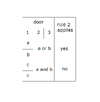DaveC426913
Valued Senior Member
phyti, humour me for a moment. Set aside theoretical and logical considerations and look at this from a fresh perspective. Look at the data of this actual sim.
Tell us where you think this sim is going wrong - give us a row number where any rule or probability is being violated.
Satisfy yourself that:
- the car is behind a random door for each of 200 games (column 2 is a sequence of randomly-chosen numbers 1-3)
- the user chooses a random door to start in each of 200 games (column 3 is a sequence of randomly-chosen numbers 1-3)
- Monty always opens a door that is not the player's choice or the car. In some games he gets to choose one of two doors, in other games he has only one door to open. (But this split result does not double the number of times it actually occurs.)
- the player always switches.
I dont mean a meta-analysis of what you think game "types" are or whatever a "composite" game might be. This is a list of 200 real, valid, independent games with 200 concrete outcomes. Literally, this could be the playbook of the last 200 episodes of the show.
Simply find any flaw in the data.
In fact, you surely don't have to review the entire list of 200; I've listed just the first 35 or so results. it has already converged on 2/3rds within the first twelve games or so.
By game twelve, the player's 'always switch' strategy has paid off eight times (i.e. 2/3rds).
Can you see why?
Feel free to run the sim yourself as many times as you want.

Are they random?
In this run of the sim:
Column 2: Car is
- behind door one 12/35 times,
- behind door two 11/35 times,
- behind door three 12/35 times.
Column 3: Player
- chooses door one 10/35 times,
- chooses door two 10/35 times,
- chooses door three 15/35 times.
Column 4: Monty opens a door
If player has chosen the door that has the car, Monty gets to open one of two doors (chosen randomly).
If player has not chosen the door that has the car, Monty has only one door he can open (since the other one has the car).
Column 5: Player switches:
Player always switches to the one remaining door.
Tell us where you think this sim is going wrong - give us a row number where any rule or probability is being violated.
Satisfy yourself that:
- the car is behind a random door for each of 200 games (column 2 is a sequence of randomly-chosen numbers 1-3)
- the user chooses a random door to start in each of 200 games (column 3 is a sequence of randomly-chosen numbers 1-3)
- Monty always opens a door that is not the player's choice or the car. In some games he gets to choose one of two doors, in other games he has only one door to open. (But this split result does not double the number of times it actually occurs.)
- the player always switches.
I dont mean a meta-analysis of what you think game "types" are or whatever a "composite" game might be. This is a list of 200 real, valid, independent games with 200 concrete outcomes. Literally, this could be the playbook of the last 200 episodes of the show.
Simply find any flaw in the data.
In fact, you surely don't have to review the entire list of 200; I've listed just the first 35 or so results. it has already converged on 2/3rds within the first twelve games or so.
By game twelve, the player's 'always switch' strategy has paid off eight times (i.e. 2/3rds).
Can you see why?
Feel free to run the sim yourself as many times as you want.

Are they random?
In this run of the sim:
Column 2: Car is
- behind door one 12/35 times,
- behind door two 11/35 times,
- behind door three 12/35 times.
Column 3: Player
- chooses door one 10/35 times,
- chooses door two 10/35 times,
- chooses door three 15/35 times.
Column 4: Monty opens a door
If player has chosen the door that has the car, Monty gets to open one of two doors (chosen randomly).
If player has not chosen the door that has the car, Monty has only one door he can open (since the other one has the car).
Column 5: Player switches:
Player always switches to the one remaining door.
Last edited:

